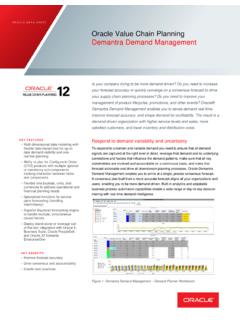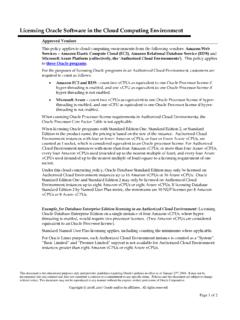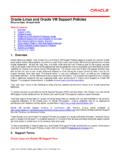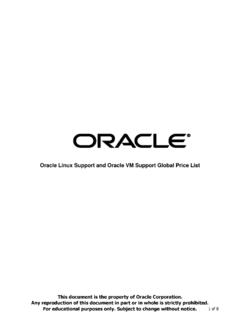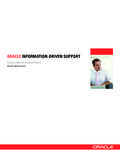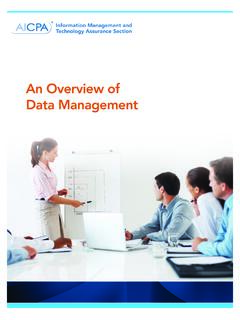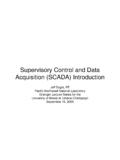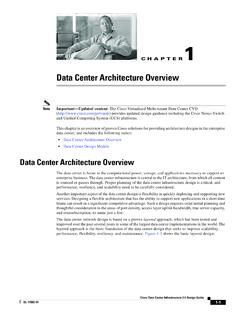Transcription of Master Data Management - Oracle
1 Master data Management An Oracle White Paper June 2010 Master data Management Introduction .. 1 2 Enterprise data .. 4 Transactional data .. 4 Operational MDM .. 5 Analytical data .. 5 Analytical MDM .. 5 Master data .. 5 Enterprise MDM .. 6 Information Architecture .. 6 Operational Applications .. 6 Enterprise Application Integration (EAI) .. 7 Service Oriented Architecture (SOA) .. 7 The data Quality Problem .. 7 Analytical Systems .. 8 Enterprise data Warehousing (EDW) and data Marts .. 8 Extraction, Transformation, and Loading (ETL) .. 9 Business Intelligence (BI) .. 9 The data Quality Problem .. 9 Ideal Information Architecture .. 10 Oracle Information Architecture .. 11 Master data Management Processes .. 13 Profile .. 14 Consolidate .. 15 Govern .. 15 Share.
2 15 Leverage .. 16 Oracle MDM High Level Architecture .. 16 MDM Platform Layer .. 17 Application Integration Services .. 17 Enterprise Service Bus .. 17 Business Process Orchestration Services .. 17 Business Rules .. 18 Event-Driven Services .. 19 Identity 19 Web Services Management .. 19 Analytic Services .. 20 Enterprise Performance Management .. 20 data Warehousing .. 20 Business Intelligence .. 21 Master data ManagementiiPublishing Services .. 21 data Migration Services .. 21 High Availability and Scalability .. 22 Real Application Clusters .. 22 Mixed Workloads .. 22 Exadata .. 22 Application Integration Architecture .. 23 AIA Layers .. 23 Common Object Methodology .. 24 MDM Foundation Packs .. 24 MDM Process Integration Packs .. 24 MDM Aware Applications .. 25 Composite Application Development .. 25 Oracle data Quality Services .. 25 Oracle Customer data Quality Servers.
3 27 Product data Quality .. 29 End-To-End data Quality .. 31 Application Development Environment .. 32 MDM Applications Layer .. 32 MDM Pillars .. 32 Oracle Customer Hub .. 33 Customer data Model .. 34 Consolidate .. 35 Cleanse .. 36 Govern .. 36 Share .. 38 Business Benefits .. 39 Product Hub .. 39 Import Workbench .. 40 Catalog Administration .. 41 New Product Introduction .. 41 Product data Synchronization .. 41 Oracle Site Hub .. 42 Golden Record for Site data .. 43 Application Integration .. 43 Effective Site Analysis and Google Integration .. 43 Oracle Supplier Hub .. 45 Consolidate .. 45 Cleanse .. 46 Govern .. 46 Share .. 46 Supplier Lifecycle Management .. 46 Business Benefits .. 46 Oracle Hyperion data Relationship Management .. 47 Automated Attribute Management .. 48 Best-of-Breed Hierarchy Management .. 49 Integration with Operational and Workflow Systems .. 49 Import, Blend, and Export to Synchronize Master data .
4 49 Versioning and Modeling Capabilities to Improve Analysis .. 50 Master data Managementiii Master data ManagementivMDM data Governance and Industries Layer .. 50 MDM Industry Verticalization .. 50 Higher Education Constituent Hub .. 50 Product Hub for Retail .. 51 Product Hub for Communications .. 51 data Governance .. 52 data Watch and Repair for MDM .. 53 MDM Implementation Best Practices .. 54 Build vs Buy .. 55 Conclusion .. 56 Master data Management INTRODUCTION Fragmented inconsistent Product data slows time-to-market, creates supply chain inefficiencies, results in weaker than expected market penetration, and drives up the cost of compliance. Fragmented inconsistent Customer data hides revenue recognition, introduces risk, creates sales inefficiencies, and results in misguided marketing campaigns and lost customer loyalty1. Fragmented and inconsistent Supplier data reduces supply chain efficiencies, negatively impacts spend control initiatives, and increases the risk of supplier exceptions.
5 Product , Customer , and Supplier are only three of a large number of key business entities we refer to as Master data . Many organizations are not realizing the anticipated ROI in their existing applications. Oracle MDM helps organizations realize the return on existing and new application investments. Through 2010, 70 percent of Fortune 1000 organizations will apply MDM programs to ensure the accuracy and integrity of commonly shared business information for compliance, operational efficiency and competitive differentiation purposes ( probability). Gartner Master data is the critical business information supporting the transactional and analytical operations of the enterprise. Master data Management (MDM) is a combination of applications and technologies that consolidates, cleans, and augments this corporate Master data , and synchronizes it with all applications, business processes, and analytical tools.
6 This results in significant improvements in operational efficiency, reporting, and fact based decision-making. Over the last several decades, IT landscapes have grown into complex arrays of different systems, applications, and technologies. This fragmented environment has created significant data problems. These data problems are breaking business processes; impeding Customer Relationship Management (CRM), Enterprise Resource Planning (ERP), and Supply Chain Management (SCM) initiatives; corrupting analytics; and costing corporations billions of dollars a year. MDM attacks the enterprise data quality problem at its source on the operational side of the business. This is done in a coordinated fashion with the data warehousing / analytical side of the business. The combined approach is proving itself to be very successful in leading companies around the world. This paper will discuss what it means to manage Master data and outlines Oracle s MDM solution2.
7 Oracle s technology components are ideal for building Master data Management systems, and Oracle s pre-built MDM solutions for key Master data objects such as Product, Customer, Supplier, Site, and Financial data can bring real business value in a fraction of the time it takes to build from scratch. Oracle s MDM portfolio also includes tools that directly support data governance within the Master data stores. What s more, Oracle MDM utilizes Oracle s Application Integration Architecture to create MDM Aware Applications3 and integrate the high quality authoritative Master data into the IT landscape. This fusion of 1 Customer data Integration Reaching a Single Version of the Truth, Jill Dyche, Evan Levy Wiley & Sons, 2006 2 Oracle Master data Management , an Oracle data Sheet, URL 3 MDM Aware Applications, an Oracle Whitepaper, URL applications and technology creates a solution superior to other MDM offerings on the market.
8 OVERVIEW How do you get from a thousand points of data entry to a single view of the business? This is the challenge that has faced companies for many years. Service Oriented Architecture (SOA) is helping to automate business processes across disparate applications, but the data fragmentation remains. Modern business analytics on top of terabyte sized data warehouses are producing ever more relevant and actionable information for decision makers, but the data sources remain fragmented and inconsistent. These data quality problems continue to impact operational efficiency and reporting accuracy. Master data Management is the key. It fixes the data quality problem on the operational side of the business and augments and operationalizes the data warehouse on the analytical side of the business. In this paper, we will explore the central role of MDM as part of a complete information Management solution.
9 High quality customer information was critically important for Areva s deployment of major new application suites, including SCM and CRM. Oracle Customer Hub provided the unique customer database that can be shared by all applications managing customer data and the critical data quality tools needed to increase our customer knowledge. With Oracle Customer Hub at the center of the Areva IT landscape, customer data is collected from all relevant applications, harmonized, merged, enriched with D&B data , and published to operational and analytical systems. ROI has been measured at 38% over 4 years with a 37 month payback. Florence Legacy, Project Manager Bruno Billy, data Manager Areva T&D Master data Management has two architectural components: The technology to profile, consolidate and synchronize the Master data across the enterprise The applications to manage, cleanse, and enrich the structured and unstructured Master data MDM must seamlessly integrate with modern Service Oriented Architectures in order to manage the Master data across the many systems that are responsible for data entry, and bring the clean corporate Master data to the applications and processes that run the business.
10 MDM becomes the central source for accurate fully cross-referenced real time Master data . It must seamlessly integrate with data warehouses, Enterprise Performance Management (EPM) applications, and all Business Intelligence (BI) systems, designed to bring the right information in the right form to the right person at the right time. The Master data Management system gave us a single, integrated view of our customers, partners, and suppliers. The information helps us run our business more effectively and ensures we make sound decisions. Kim Hyoung-soo, Section Chief Process Innovation Team, MDM Section Hanjin Shipping In addition to supporting and augmenting SOA and BI systems, the MDM applications must support data governance. data Governance is a business process for defining the data definitions, standards, access rights, quality rules. MDM executes these rules.
